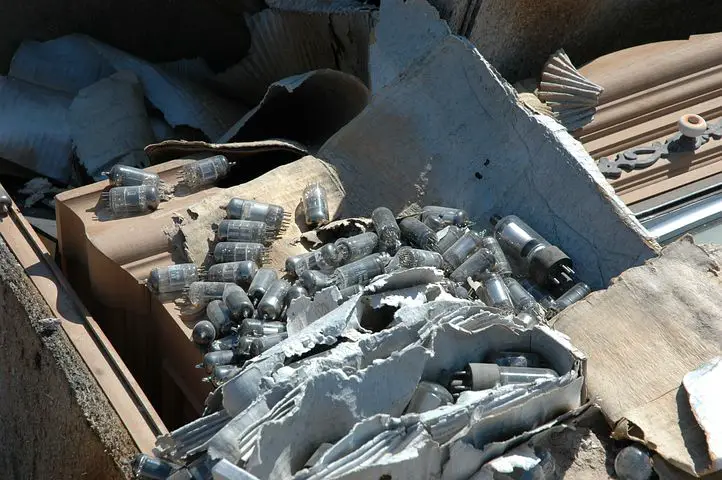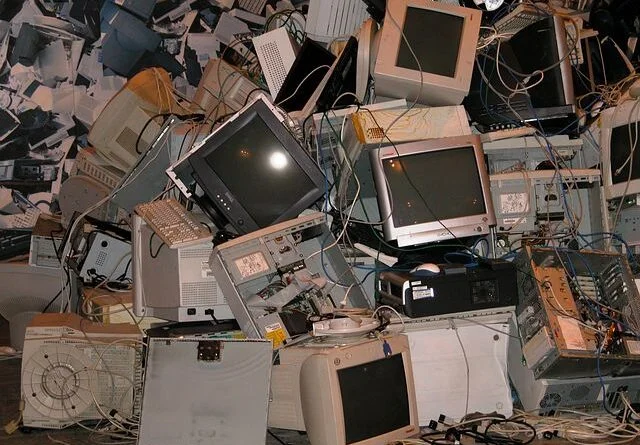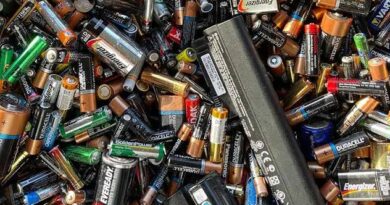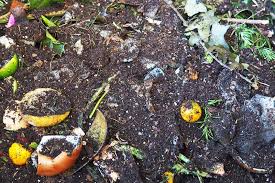The Products Derived From Electronic Waste (E-waste)
Electronic waste, or e-waste, is the term used to describe discarded electronic equipment or gadgets that are no longer in use or are out of date. This may apply to electronics including computers, TVs, mobile phones, refrigerators, and air conditioners, among others.
Many electronic gadgets include risky components including lead, mercury, cadmium, and brominated flame retardants that may be dangerous to the environment and human health, making e-waste a serious issue. These dangerous components of e-waste may leak into soil and water if it is not properly disposed of, contaminating the environment and endangering human health.
Moreover, expensive elements like gold, silver, and copper that may be recycled and reused are often found in electrical gadgets. Even yet, a large portion of the e-waste created today is not adequately recycled or disposed of, resulting in substantial resource waste.
Encourage appropriate electronic device disposal and recycling to combat the problem of e-waste. This may include recycling non-functioning electronics in the right ways as well as giving functional devices to organizations or repairing them for reuse.
Several nations and organizations have put legislation and efforts into place to encourage ethical e-waste disposal and recycling, but more needs to be done to guarantee that it is properly handled and that its effects on the environment and public health are minimized.
The Products Derived From Electronic Waste (E-waste)

Several businesses and people have discovered methods to recycle and reuse these gadgets to produce new goods rather than just throwing them away as e-waste. The following are some examples of goods that may be made from electrical waste:
(1) Items made of recycled plastic
Many of the plastic parts included in e-waste may be recycled to create new items like phone cases, laptop covers, and other plastic accessories. It is possible to lessen the quantity of garbage that pollutes the environment or ends up in landfills by recycling plastic from electronic waste. Following are some examples of items manufactured from electrical trash and recycled plastic:
Phone cases: A lot of phone cases are made of plastic, and new phone cases may be generated by recycling plastic from electronic trash. This may aid in lowering the quantity of virgin plastic needed to produce phone cases.
Computer accessories: Plastic from discarded electronics may be utilized to create monitor stands, mouse pads, and keyboard covers.
Storage containers: Bins, crates, and baskets may be made out of plastic recovered from technological trash. These bins may be used for a variety of things, including the storage of clothing, toys, or office materials.
Furniture: Chairs and tables may be made from recycled plastic that is found in electronic garbage. By doing this, you may be able to utilize less wood or other resources to manufacture furniture.
Building supplies: Plastic that has been recycled from electronic trash may be utilized in construction projects. For outdoor decking, fencing, and other outdoor buildings, recycled plastic may be used to create plastic timber.
Automotive components: Plastic from electronic trash may also be utilized to make automotive components including dashboards, door panels, and bumpers for automobiles.
We can cut down on landfill trash, preserve natural resources, and lower greenhouse gas emissions linked to the manufacturing of new plastic items by recycling plastic from technological waste.
Read Also: The Products Derived From Demolition Waste
(2) Used electronic devices
Many gadgets may be repaired and resold to customers who would not be able to buy new equipment at a cheaper price. This reduces e-waste and gives people in need of gadgets inexpensive options.
Electronics that have been used or discarded but then repaired to work like new are referred to as refurbished. Electronic garbage, or “e-waste,” is a common source of refurbished electronics.
E-waste is a word used to describe electronic equipment that has been abandoned, including computers, TVs, cellphones, and other electronic equipment. Since many electronics include toxic compounds including lead, mercury, and cadmium, e-waste may be dangerous to the environment if improperly disposed of.
Electronics refurbishing may lessen e-waste and the harmful effects on the environment. Also, it gives people and businesses the chance to buy gadgets for less money than they would pay for brand-new ones.
Electronic gadgets that have been refurbished go through a comprehensive cleaning and testing procedure to make sure they adhere to the same standards as brand-new gadgets.
The devices are reprogrammed or reset to their factory default settings when any damaged components are replaced. The price of refurbished gadgets is therefore lower than that of new ones. Yet it’s crucial to understand that not all reconditioned devices are the same.
Although some refurbished products are returned to their pre-owned state, others could have visual flaws or not perform as well as brand-new products. Consequently, it’s crucial to buy reconditioned gadgets from a reliable merchant that backs up their goods with warranties and guarantees.
Repurposing electronics from e-waste is an excellent approach to cut down on electronic waste and provide people and businesses access to inexpensive technology. To make sure you’re obtaining a high-quality item, you should be careful and only buy reconditioned gadgets from reliable vendors.
(3) Jewelry
Metals like gold, silver, and copper that may be recovered from e-waste and used to produce jewelry are present. With businesses like Dell producing a jewelry line made completely from recycled gold, this has recently become a trendy trend.
A new development in sustainable fashion is jewelry manufactured from electronic garbage, or “e-waste.” As we use more electronic gadgets, e-waste is becoming a bigger issue in our society. Many of these items wind up in landfills or incinerators, where they cause environmental pollution and health issues.
By making jewelry out of e-waste, we can lessen the amount of trash dumped in landfills and make stunning, one-of-a-kind items. E-waste may be converted into jewelry in a number of ways. One strategy is to take apart electrical gadgets, such computer or mobile phone parts, and make jewelry from the individual bits.
For instance, computer keys may be used to make bracelets or necklaces, and circuit boards can be chopped and molded into earrings or pendants. Another strategy is to develop jewelry that incorporates e-waste components using 3D printing technology. This makes it possible to create detailed and sophisticated patterns that may be altered to suit personal tastes.
Making sure the components are secure to wear is a key factor when using e-waste to make jewelry. Certain electronic parts have hazardous substances including lead, mercury, and cadmium that are dangerous to consume or breathe in. It is essential to collaborate with a seasoned jeweler or artist who is familiar with handling e-waste properly.
A unique and environmentally friendly approach to reuse electrical gadgets and cut down on waste is to make jewelry from e-waste. It is also a fantastic approach to encourage more sustainable practices in the garment sector and raise awareness of the significance of proper e-waste disposal.
Read Also: Dog Waste Complete Management Guide
(4) Home goods
E-waste is now being used by certain businesses to create furniture like chairs and tables. This may provide a distinctive appearance while minimizing the environmental effect of furniture manufacture. E-waste, commonly referred to as electronic garbage (e-waste), is a relatively new idea that is gaining acceptance in the sustainable design community.
E-waste, which includes outdated electrical gadgets including computers, cellphones, TVs, and other electronics, is a fast expanding waste stream. This kind of garbage is an issue since it includes potentially harmful substances that, if improperly disposed of, might harm the environment.
But, some designers and artists are coming up with inventive solutions to transform e-waste into useful and lovely furniture. Circuit boards, computer chips, and other electrical parts, for instance, may be repurposed into distinctive patterns and textures that can be applied to furniture surfaces. You can make seats and tables out of old computer cases and monitors.
Reducing the quantity of garbage that is dumped in landfills is one advantage of integrating e-waste in furniture design. Designers may also produce one-of-a-kind, ecologically responsible, and aesthetically pleasing products by upcycling e-waste.
But, it’s crucial to remember that handling e-waste may be risky since it often includes harmful materials like lead, cadmium, and mercury. While processing e-waste, it’s important to adhere to the right safety procedures, which include donning protective gear and utilizing the right tools and equipment.
Also, care must be taken to eliminate any dangerous elements from any e-waste utilized in furniture design. E-waste furniture is an exciting and cutting-edge field of sustainable design that has the ability to minimize waste and produce one-of-a-kind, eco-friendly furniture items.
(5) Art
E-waste may be utilized to make sculptures and installations, among other types of artwork. In addition to using the garbage in a new way, this also produces new art. A kind of creative expression known as “art from electronic waste,” often referred to as “e-waste art” or “tech art,” entails the production of sculptures, installations, or other pieces of art from abandoned electronic parts and gadgets.
A unique technique to raise awareness of the problem of electronic waste and its effects on the environment is via e-waste art. From elaborate installations to tiny sculptures, e-waste art may take many different shapes. Circuit boards, cables, computer bits, even outdated appliances, are just a few of the electrical gadgets and materials that artists often use to create one-of-a-kind, eye-catching works of art.
The “E-Waste Warrior” sculptures by Kenyan artist Cyrus Kabiru, which are created from discarded electronics and fashion accessories, and the “E-Waste Cathedral” installation by Ghanaian artist Bright Tetteh Ackwerh, which is created from discarded keyboards and computer parts, are two notable examples of e-waste art.
Making art from electronic trash encourages recycling and sustainability as well as awareness-building about the problem of e-waste. E-waste artists are assisting in the reduction of electronic trash that ends up in landfills and promoting a more sustainable future by turning outdated gadgets into works of art.
(6) Sources of Renewable Energy
Renewable energy sources like solar panels and wind turbines may be made from e-waste. These gadgets are constructed using e-waste components like silicon and rare earth metals. E-waste, also known as electronic garbage, is a rising environmental issue as more and more electronic gadgets are thrown away.
The possibility to recover valuable minerals for use in renewable energy systems is also provided by e-waste, however. These are some instances of how e-waste may be used to create sustainable energy sources:
Solar Cells: Electronic gadgets like computers and cell phones often use silicon-based solar cells. The silicon in these devices may be removed and utilized to create new solar cells by recycling them.
Lithium-ion batteries are utilized in many different electronic devices, including computers and cellphones. These batteries are recyclable and may be used to store energy in wind or solar energy systems, among other renewable energy sources.
Components for Wind Turbines: Sensors, motors, and controllers from scrapped electronic equipment may be utilized to construct wind turbines. The price of constructing a wind turbine may be greatly decreased by recycling these parts.
Biofuels: Organic materials found in e-waste, such paper and plastic, may be utilized to make biofuels. In renewable energy systems, these fuels may be utilized to power cars or generators.
Geothermal Energy: Materials needed in the building of geothermal power plants, such as neodymium and dysprosium, may be found in electronic trash. These metals are recoverable and used in fresh geothermal initiatives.
E-waste is an important resource that may be used to produce sustainable energy. We can lessen the negative effects of electronic waste on the environment while also assisting in the switch to a more sustainable energy system by removing and reusing elements from outdated gadgets.
Read Also: 40 Home Improvement Ideas for Those On A Budget



